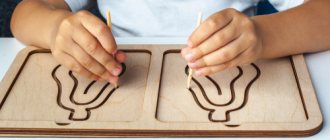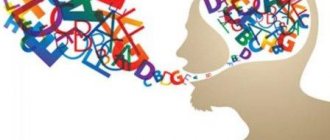Causes
Alalia develops as a speech disorder of a neurological nature, the causes of its occurrence are:
- in the perinatal period - toxicosis, hypoxia, intrauterine infection of the fetus, fall of a pregnant woman, resulting in injury to the fetus, development of heart failure in the mother or fetus, etc.;
- during childbirth - prematurity of the fetus, asphyxia of newborns, the presence of intracranial trauma in the fetus caused by premature birth, inept use of instruments by obstetricians, etc.;
- in the first years - long-term and frequent illnesses (especially during the first year of a child’s life), surgical intervention under general anesthesia, mechanical trauma, the body’s reaction to vaccinations, etc.
Alalia is divided into sensory and motor, depending on the predominant component of the disease being isolated - sensory or motor.
With motor alalia, areas of the brain responsible for speech production are affected. For this reason, children do not develop expressive speech, although speech understanding is preserved. Motor alalia is often accompanied by neurological symptoms, affecting mainly the motor activity of the child, which is manifested in awkward and insufficiently coordinated movements, weak motor skills of the fingers of the upper extremities and decreased gross motor skills.
A child suffering from motor alalia can be either too mobile and active, or too inactive and inhibited. Most of these children have reduced performance, get tired quickly, and their motor function of the whole body is impaired.
With sensory alalia, speech in children is often completely absent, and understanding the speech of strangers is also impaired. As a result, children retain physical hearing, but cease to perceive the speech of people around them, since the development of sensory alalia entails damage to the areas of the brain responsible for the auditory perception of speech and its further analysis.
A child with alalia with a predominant sensory component regularly faces many everyday problems, since impaired motor skills are layered on impaired speech perception, rapidly developing into a communicative disorder, as a result of which it becomes difficult for the child to understand peers, since their speech is no longer perceived by him. The result is often impulsive or, conversely, withdrawn behavior, fatigue and inability to concentrate. Often, such a diagnosis resembles autism in its symptoms, and therefore great importance is attached to the correct diagnosis.
Our center has developed and launched a special diagnostic program, thanks to which the diagnoses of sick children can be clearly identified, separating alalia and autism.
Alalia and aphasia
Alalia is a complete or partial absence of speech in the presence of sufficient intellectual capabilities, hearing acuity and speech motor organs for the development of speech.
Aphasia is the loss of existing speech while maintaining the peripheral speech organs. Alalia based on underdevelopment, destruction or inhibition of the speech systems of the cerebral cortex before the formation of more or less stable speech (up to the age of three), as a result of which the formation of temporary conditioned connections in the second signaling system is impossible or difficult. This delays speech development. Disruption of normal brain activity is caused by a variety of reasons: prenatal, natural and intravital (illness, bruises, nervous shock). Prof. N.I. Krasnogorsky notes the influence of digestive and nutritional disorders on the development of children's speech. Alaliki, left to their own devices, sometimes begin to speak babblingly only at the age of 8-10 and, without training in special institutions, remain with defective speech for the rest of their lives.
Among alaliks there are children who, to a limited extent, understand the speech of others, but do not speak ( motor alalia ). In such children, the formation of conditioned connections is disrupted, mainly in the motor (kinesthetic) speech systems of the cerebral cortex. But since the auditory-speech analyzer is directly connected with the speech-motor analyzer, the understanding of speech in motor alaliks is sharply limited: they understand only specific things, mainly from the area of household use or kindergarten. Other alaliks do not understand speech at all, and therefore do not speak, although their ability to form sounds is sufficiently preserved in the form of mechanical repetition. The misunderstanding in this case is based on acoustic agnosia (phonemic hearing is impaired): The child hears speech, but does not understand it. There is no connection between the first and second signaling systems. This is a sensory (sensitive) alalia.
There are no pure forms of alalia: in some, sensory impairments predominate, in others, motor impairments predominate. This connection is explained by the holistic functioning of our brain. As a rule, alaliki very rarely enter kindergartens; by this time their speech usually begins to develop slowly. But even at the age of five or six, their speech is agrammatic, consisting of an extremely limited, predominantly babbling vocabulary of an everyday nature. Motor alaliks speak slowly, heavily, with difficulty, they squeeze the words out of themselves with effort. Speech is characterized by rearrangement of sounds and syllables and contamination. Alaliki do not want to speak in the motor form due to the difficulty of the act of pronunciation, partly due to a limited understanding of speech, in the sensory form - due to a lack of understanding of speech. This makes it difficult for them to learn normal speech.
Aphasia differs from alalia in that it always occurs in a child as a result of organic damage to certain areas of the cerebral cortex (pathological “foci”), moreover, during the period of more or less developed speech, at the age of no earlier than 2.5-3 years. Along with organic lesions, under their influence, inhibited foci appear in the speech systems. When disinhibition occurs, their speech is restored to one degree or another (often without special training).
In aphasia, motor and sensory forms also differ. Sensory aphasia should not be confused with the speech of the hard of hearing, with which young children have many external similarities. In aphasia, the higher analysis and synthesis of auditory-verbal stimuli reaching the brain is impaired. Therefore, it is impossible to form speech stereotypes from them either for pronouncing or understanding speech. Speech in aphasics develops slowly and with great difficulty, words are poorly remembered and sharply distorted, and are often grasped by guesswork. Only in rare cases does it develop to normal.
In children who are hard of hearing, the central end of the auditory-speech analyzer is preserved, and the lack of their speech mainly depends on the fact that higher analysis and synthesis process the inferior auditory-speech stimuli that come to their disposal. Speech development in them proceeds incomparably faster and more often reaches the norm than in aphasics.
A significant difference between an aphasic, predominantly motor, and an alalik is the preservation (in unadvanced cases) of the desire to speak; some words and phrases from previous speech remain. This facilitates the restoration and further development of speech. A big obstacle to the mastery of speech by alaliks and aphasics around them is poor memorization and rapid forgetting of words and phrases, i.e. difficulty and fragility of closures in defective speech systems of the cerebral cortex.
Khvattsev M. E.
Treatment
Treatment of alalia requires an integrated approach. The first thing that needs to be done is to accurately confirm the diagnosis with a speech neurologist. If neurological disorders correspond and are confirmed by a number of functional studies, the purpose of which is to assess the conductivity of the auditory nerves, the patient is prescribed drug therapy.
The work of speech neurologists at our center is based on expert therapeutic protocols; they prescribe medications to children with great care, trying to choose those medications whose use will not lead to unpleasant side effects.
Simultaneously with taking medications, an individual correctional route is built for each little patient; this activity is carried out by the department of therapeutic pedagogy of the center. Treatment of alalia requires the mandatory participation of a neuropsychologist and speech therapist-rehabilitation specialist in the process.
Also, to increase the therapeutic effect, the center uses the standard of neurorehabilitation used in Europe. This non-invasive therapeutic method helps restore nerve connections in the patient’s cerebral cortex.
Article:
Alalia is the absence or underdevelopment of speech due to organic damage to the speech areas of the cerebral cortex in the prenatal or early period of a child’s development.
What is the difference between alalia and deaf-muteness?
With alalia, hearing function is preserved. Hearing research plays a decisive role. A deaf person is characterized by a complete lack of reaction to sound stimuli. You can call out to the child behind his back or hit a musical instrument. Alalik will give a normal indicative response. Important! Do not make sounds with additional vibration, do not knock, do not clap. The child is referred to an audiologist for an audiometric hearing test. Typically, deaf children use gestures without sound accompaniment, and speech does not appear without special training. Alalik gives a sound reaction to gestures (non-verbal vocalization). Unlike deaf people, Alaliks have perfectly preserved prosody.
The difference between sensory alalia and hearing loss.
Audiometric hearing test. If you increase the volume of your voice, a child with hearing loss will hear better and respond. For touch alik, volume will not improve speech understanding. Alaliks have a ringing voice, while children with hearing loss have a muffled voice. Children who are hard of hearing try to repeat words, but alalik does not.
For anarthria and dysarthria.
In children with alalia, the motor level of speech production is completely or relatively preserved. They can perform articulatory movements in full. In children with anarthria and dysarthria, articulatory motor impairments are leading in the structure of speech defects. With alalia, the entire language system is upset, with anarthria - only one of its subsystems is phonetic, due to the presence of paresis and paralysis.
Difference between alalia and aphasia
The difference is in the anamnesis: the effect of harmful factors is observed in the prenatal and early postnatal periods (up to 3 years). In childhood aphasia - after a period of intensive speech development. If a child ever spoke better than during the examination, this is aphasia. An aphasic person exhibits “splinters” of previous speech. With alalia, targeted intensive formation of the speech system is necessary. With aphasia, spontaneous restoration of speech is possible.
For severe speech delay
One of the most difficult cases of differential diagnosis. Alalia is characterized not only by delayed speech development, but, above all, by a pathological type of language acquisition. A child with a tempo developmental developmental disorder most often exhibits varying degrees of impairment of articulatory motor skills and a slight lag in the formation of language ability in expressive speech. With alalia, the motor sphere is preserved, but gross violations of the lexico-grammatical system are expressed, the manifestations of which are not characteristic of children's speech in the early stages of its development. Children with delayed speech development often spontaneously, without special training, master language, which does not happen in children with alalia. An important diagnostic criterion is the ability and speed of learning new words.
Difference from speech pathology caused by mental retardation.
Speech impairment in alalia occurs with relative preservation of nonverbal mental operations. Speech disorders in UI are the result of pathology of cognitive activity. The decisive role is the examination of thinking at the non-verbal level.
Motor alaliks understand spoken speech well and follow instructions, which three-year-old children with disabilities may not be able to do. At school age, alaliki try to express and understand complex cause-and-effect relationships. Children with ID either do not express them at all, or only the most elementary ones.
With alalia, there are language speech disorders in the form of agrammatism and phonemic disorders. In mentally retarded children, speech is primitive, but correct in formal linguistic terms.
Children with alalia have a large stock of “subject knowledge”. Children with intellectual disabilities easily update simple words, but when shown low-frequency object pictures, there will be errors and refusal.
Children with motor alalia have preserved nonverbal thinking and a higher degree of learning ability. During the examination, a training experiment is used. They show how to complete the task and see whether the child takes the hint or not. Children with motor alalia, unlike children with mental retardation, are critical of their speech impairment.
From early childhood autism
A condition similar to sensory alalia. Autistic people come across as children with sensory alalia. A child with early childhood autism does not respond to spoken language, does not make eye contact, avoids touch, or reacts to it by screaming and crying. Such children do not have the words mom and dad, and there may be constant mumbling, including a variety of sounds, including complex ones. Echolalia is characteristic of both categories. Pronounced psychopathological symptoms for early childhood autism: stereotypies, stimulation (tactile, olfactory). Changing the usual image leads to violent reactions. Coldness towards mother.







